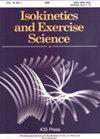Heart rate variability: Obtaining the stress score from SDNN values
IF 0.7
4区 医学
Q4 ENGINEERING, BIOMEDICAL
引用次数: 0
Abstract
BACKGROUND: Heart Rate Variability (HRV) is a non-invasive method of assessing the autonomic nervous system response during exercise and fatigue. OBJECTIVE: The aim of the study was to analyze the validity and feasibility of the stress score index (SS) calculated from SDNN values during exercise. METHODS: 18 Men performed 2 running tests: 1) incremental exercise test; 2) 10-minute constant load test. Subjects underwent HRV analysis during the constant load test, before both tests, and afterward in a seated position at 3 intervals (0’–5’, 5’–10’, 10’–15’). The relationship between SDNN and SD2 was analyzed before, during, and after the test. SS was calculated as 1/SD2*1000. The Bland-Altman test analyzed the reliability of ESS. The bias, limits of agreement (LoA), standard deviation of difference, intraclass correlation (ICC), and person coefficient were calculated. RESULTS: The bias was 0.15 ± 2.54 (UperLOA: 2.54; LowerLOA: -2.23). In all conditions, SD2 and SDNN showed a positive linear relationship (r2 = 0.986); SS and ESS were correlated; and SS and ESS described a positive linear relationship (r2 = 0.993). CONCLUSIONS: The SS index calculation from SDNN is a reliable alternative during exercise.心率变异性从 SDNN 值获得压力评分
背景:心率变异(HRV)是评估运动和疲劳时自律神经系统反应的一种无创方法。目的:本研究旨在分析根据运动时的 SDNN 值计算出的压力评分指数(SS)的有效性和可行性。方法:18 名男性进行了 2 项跑步测试:1)增量运动测试;2)10 分钟恒定负荷测试。受试者在恒定负荷测试期间、两项测试之前和测试之后以坐姿在三个间隔(0'-5'、5'-10'、10'-15')进行心率变异分析。在测试前、测试中和测试后分析了 SDNN 和 SD2 之间的关系。SS 的计算公式为 1/SD2*1000。布兰-阿尔特曼检验分析了 ESS 的可靠性。计算了偏差、一致性限(LoA)、差异标准偏差、类内相关(ICC)和人系数。结果:偏差为 0.15 ± 2.54(UperLOA:2.54;LowerLOA:-2.23)。在所有条件下,SD2 和 SDNN 呈正线性关系(r2 = 0.986);SS 和 ESS 呈相关关系;SS 和 ESS 呈正线性关系(r2 = 0.993)。结论:根据 SDNN 计算出的 SS 指数是运动期间的一种可靠替代方法。
本文章由计算机程序翻译,如有差异,请以英文原文为准。
求助全文
约1分钟内获得全文
求助全文
来源期刊

Isokinetics and Exercise Science
医学-工程:生物医学
CiteScore
1.20
自引率
14.30%
发文量
37
审稿时长
>12 weeks
期刊介绍:
Isokinetics and Exercise Science (IES) is an international journal devoted to the study of theoretical and applied aspects of human muscle performance. Since isokinetic dynamometry constitutes the major tool in this area, the journal takes a particular interest in exploring the considerable potential of this technology.
IES publishes studies associated with the methodology of muscle performance especially with respect to the issues of reproducibility and validity of testing, description of normal and pathological mechanical parameters which are derivable from muscle testing, applications in basic research topics such as motor learning paradigms and electromyography. The journal also publishes studies on applications in clinical settings and technical aspects of the various measurement systems employed in human muscle performance research.
The journal welcomes submissions in the form of research papers, reviews, case studies and technical reports from professionals in the fields of sports medicine, orthopaedic and neurological rehabilitation and exercise physiology.
 求助内容:
求助内容: 应助结果提醒方式:
应助结果提醒方式:


